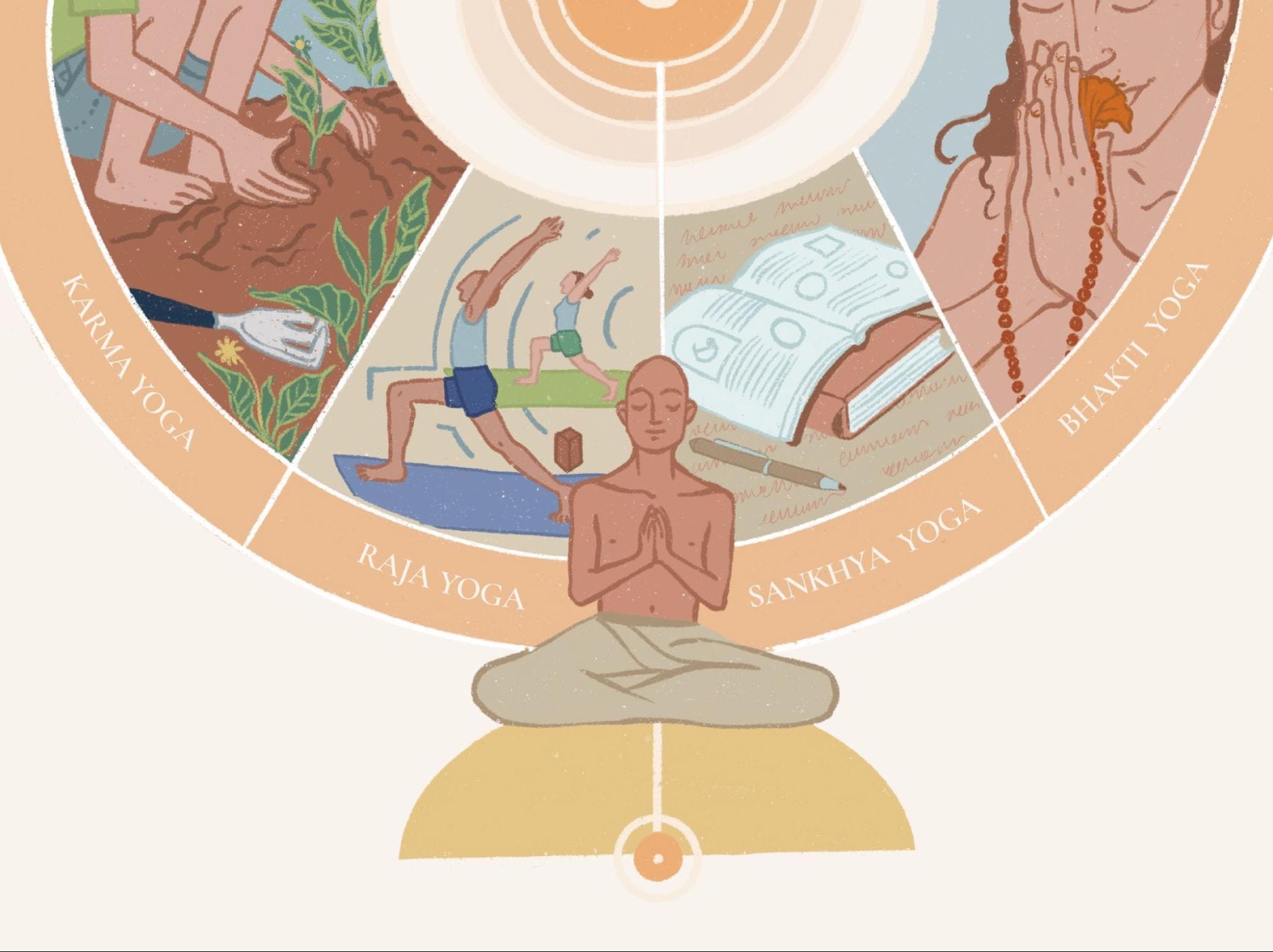
Illustrated by Himanshi Parmar
Disclaimer: Yoga is essentially a spiritual philosophy with an endeavor to understand and unionize within ourselves, with our communities & environment, and also, with God. The word God can have many-layered interpretations as higher consciousness, supreme controller, divinity, almighty, etc. While we may use the term God, it is not aligned with any religious beliefs or dogma and the word can be interpreted as you deem a comfortable concept for yourself.
To celebrate the International Day of Yoga on the 21st of June, we shall be taking you on a journey of understanding the holistic aspects of yoga and its philosophy. There has been an incremental growth in the awareness of yoga in the past few years and whether you are deeply entrenched in the practice or completely new to the term itself, we hope our 3 part blog series will help shed more light on this incredible ancient wisdom.
What is ‘yoga’?
The word ‘yoga’, like many Sanskrit words, cannot be directly translated into English. It has many definitions and nuances.
The word ‘yoga’ means :
- union; tying the strings of the mind, body, and soul together.
- active and conscious change to attain what was previously unattainable.
- to do, to practice, to be disciplined.
Hence any tiny action of ours can be on the path of ‘yoga’. It is essential while practicing yoga to attempt to direct all of our attention without any distractions, interruptions, or wanderings. No multi-tasking or else it’s not yoga!
The purpose of yogic practices is, in its essence, for a deeper and higher realization of and connection to the Self and Supreme. The practices help us concentrate our minds and live with more focus and dedication. Yoga in all its paths helps us become more aware and see with more clarity, removing ‘avidya’ (incorrect perception) which is often described as a film covering our eyes- hindering us from seeing the world as it is. Yoga is a path of self-acceptance, accepting where we are- here and now.
It is important to understand that yoga is not a goal we have set for ourselves in the future but a process-oriented practice where every small or big action counts. Ultimately, practicing yoga in any or all its forms enables us to improve ourselves, our relationships, our health, and everything we do.
What is the history of yoga?
Within Vedic philosophy[1], the wisdom of yoga and its practice has existed from the beginning of time, since the creation of the world. It has been accessed, developed, and written by Brahmins (priests) and Rishis (sages, truth seers) through study, observation, meditation, and practices through the ages in modern-day India.
As the passing of wisdom was an oral tradition, the lack of written records makes history unclear. The word ‘yoga’ is said to have first appeared in the Rig Vega about 5000 years ago, but it is likely that refers to Astanga Yoga's practice specifically. Historians believe that the wisdom is perhaps over 10,000 years old.
Some key texts bringing the practice of yoga to light are the Bhagavad Gita (considered to be completed around 200 BCE though there is much speculation). The Bhagavad Gita is a conversation between Lord Krsna and his friend and devotee, warrior-prince Arjuna within which Krsna illuminates the essence of the Vedas. The Bhagavad Gita is considered the primary spiritual text of Vedic philosophy.
Patanjali’s ‘Yoga Sutras’ which consolidated the practices of Raja yoga as the Astanga yoga practice (8 limbs) was said to be written in the 2nd century BC. It has been the essential guiding text on the practice of yoga today.
Swami Vivekananda was one of the first yogis to come to the West and share the ancient wisdom in the late 1800s. Many yogis have followed including B.K.S Iyengar who has been essential in spreading aspects of yoga philosophy all over the world. The A.C Bhaktivedanta Swami Prabhupad has been pivotal in the spread of Bhakti yoga and Krsna Consciousness in the West since the 60s, which has given more light to the overall philosophy and practice of yoga.
[1] Veda means knowledge. Vedic philosophy is an umbrella term to capture the essence of the Vedas which are a large body of texts that outline the essential principles of life.
Paths of Yoga
There are essentially four yogic paths one may journey on. “These four paths are like the branches of a tree or tributaries of a river. They all have the same source and resting place. In essence, they are all the same.”[2] What differentiates the paths are the aspects of us that are most active when practicing.
It is recommended to follow a path best suited to your natural propensities- there is no hierarchy. All the paths are interlinked and feed into each other. Developing practices on one path develops aspects of other paths as well. One must also follow the paths in line with and centered upon the essential yogic philosophy.
[2] https://artsandculture.google.com/story/the-four-paths-of-yoga-sivananda-yoga-vedanta-centres-ashrams/QQURiPuOVM2eIw?hl=en
The four paths are:
Karma Yoga: Path of Action
working with the body and using physical activity to practice yoga
Raja Yoga/ Ashtanga Yoga: Path of Transforming Energy
working with transforming and controlling energy to practice yoga
Sankhya Yoga: Path of Intelligence
working with intelligence and knowledge path to practice yoga
Bhakti Yoga: Path of Devotion
working with emotions, love and devotion to practice yoga
“In the world I am a Karma Yogi, performing my actions for others and the Lord. In the company of my friends, family, and students I am a Jnani Yogi. And in the depths of my heart, in my most private chambers, I am a Bhakti Yogi, offering complete love and devotion to the One.”
Pandit Rajmani Tigunait[3]
Karma Yoga
“One who performs his duty without attachment, surrendering the results unto the Supreme Lord, is unaffected by sinful action, as the lotus leaf is untouched by water.”
Bhagavad Gita 5.10

‘Karma’ means activities, ‘to do’. Karma yoga hence is the yoga of action- selfless action relinquishing the desire for sense-gratification, without expecting any rewards. Karma yoga is practicing service and our duties- to ourselves, our community, our environment, and the divine.
This path is best for individuals who like to work with their bodies and are action-driven.
It should not be misinterpreted that in doing actions that we do not wish to do and begrudgingly putting others in front of us, we are practicing ‘Karma Yoga’. The very essence of yoga has intention at the root of it. If it does not come from within but is guided by external forces, it is not yoga.
Karma Yoga can be practiced through every action of our lives. It is the practice of devoting oneself to the quality of action without being attached to the results. To do simply for the love and devotion of doing, consciously and with care.
Practice: Often people think practicing Karma Yoga is to do some charity, to donate our time to a cause. However, practicing can start at home, within oneself. Practice the art of acting with love and devotion to any task whether it be washing dishes, cooking, cleaning, or helping your friends and family. Pay attention to your thoughts and feelings when performing all your actions and try to focus your attention on the action itself. Do it with all your best intention and without the expectation of reward. That outcome is perfect if you put your best intention in.
Raja Yoga
“Shutting out all external sense objects, keeping the eyes and vision concentrated between the two eyebrows, suspending the inward and outward breaths within the nostrils, and thus controlling the mind, senses, and intelligence, the transcendentalist aiming at liberation becomes free from desire, fear, and anger. One who is always in this state is certainly liberated.”
Bhagavad Gita 5.27- 5.28
Raja literally translates to ‘royal’ and this path is to realize your supreme self by the transformation and controlling of energy through self-discipline and dedicated practice. Yoga simply means to be in perfect tune. When you are in yoga, your body, mind and energy, and existence are in absolute harmony. It takes active practice with your body, mind, and breath to develop and maintain this harmony. This is the practice of Raja Yoga which entails the practice of yoga we are most familiar with today.
Within Raja Yoga, we work with controlling and transforming the energy within us and coming to a sense of peace and calm quiet in an endeavor for samadhi (enlightened state of consciousness). The goal is to achieve balance, strength, suppleness, and peace to better serve ourselves, the community, the environment, and divinity, and hence Raja Yoga can be practiced by anyone.

Practice: If you are already in a yoga class, take your practice deeper by understanding the holistic aspects of Raja Yoga, the desired intentions, and the other practices. Our next article outlines the aspects of the Raja Yoga path designed by Patanjali in the Yoga Sutras and will give you in-depth detail on how to develop this practice.
Sankhya / Jnana Yoga
“One must deliver himself with the help of his mind, and not degrade himself. The mind is the friend of the conditioned soul, and his enemy as well.”
Bhagavad Gita 6.5
“For him who has conquered the mind, the mind is the best of friends; but for one who has failed to do so, his mind will remain the greatest enemy”
Bhagavad Gita 6.6

Jnana or Gnana means ‘to know, to gain knowledge. Often interchanged with Sankha/Samkhya Yoga (Sankhya means to count), Jnana Yoga is the path of knowledge, self-inquiry, and self-realization through the speculative philosophical search for the truth. The practice entails studying texts, lectures, and practices with your teacher (guru), reflection, and meditation.
This path would be chosen by individuals who have a very active and inquisitive mind and tend towards deep and philosophical thinking.
The studying and practicing of this path illuminate the discernment of what is ‘real’ and ‘unreal’, fixed and changing. In Vedic philosophy, that which is constantly changing (matter) is unreal and part of the material illusion ‘Maya’ and hence what is fixed ‘God, the spirit’ is real and unchanging. “Jnana Yoga is the process of converting intellectual knowledge into practical wisdom[4]”.
It is important when journeying on the path of any yoga practice that the essential principles of selfless devotion and a desire for a deeper understanding of self (and/or God) without attachment to the results, are inherently practiced.
Practice:
Practice Jnana Yoga by studying ancient texts like the Bhagavad Gita, and the Upanishads that outline the philosophy of the world and the individual as per Vedic philosophy. This is best done under the guidance of a spiritual teacher.
For some, Vedic wisdom may not be the guiding knowledge. One can practice Jnana Yoga by meditating and observing one’s thoughts and feelings without judgment. This process is an inquiry into oneself.
Bhakti Yoga
“If one offers Me with love and devotion a leaf, a flower, fruit a water, I will accept it.
O son of Kunti[5], all that you do, all that you eat, all that you offer and give away, as well as all austerities that you may perform, should be done as an offering unto Me.”
Bhagavad Gita 9.26 & 9.27
Bhakti Yoga is the path of developing unconditional love and devotion. While in Vedic philosophy, Bhakti is developing love and relationship with the Divine, it permeates through all our relationships. It is an endeavor to see and seek divinity in all aspects of material and spiritual life. Bhakti Yoga is practiced through your heart, endeavoring to develop a deep and loving relationship with the Divine. The intention of all yoga paths is to decrease the false ego and purify the mind, emotions, and soul.
Bhakti Yoga is a path that is best suited to people that are emotional in nature as it taps into and illuminates the empowering emotion of love.
There is a deep sense of surrender in practicing Bhakti Yoga, accepting that we are all part of the cosmic intelligence and the intention is to be one with the Divine Cosmic Consciousness. Bhakti Yoga practice also recognizes that to empty our minds and hearts is an incredibly difficult, if not impossible, process and hence outlines a path to fix our thoughts and emotions and practice serving and devoting ourselves to God.
Practice: Within the yogic tradition in India, we practice Bhakti Yoga by chanting mantras of the names of a deity that one finds affinity with, singing (kirtan) in the devotion of the lord, gathering with other practicing devotees, and engaging in devotional service endeavoring to think of and please God in all actions. God, however, doesn’t have to fall into any prescribed religion. The practice is to connect you with your source/higher consciousness/divinity but most importantly, connect you to love. You can practice Bhakti Yoga by developing a loving and devotional relationship with your parents, friends, and partners.

Curious about more aspects of yoga? You can read our next blog here which breaks down the yoga philosophy of Raja Yoga which includes asanas (postures), dhyana (meditation), and pranayama (breath-work) that many would be familiar with.
Notes:
All quotes from the Bhagavad Gita have been quoted from ‘Bhagavad Gita As It Is’ translated by Bhaktivedanta Swami Prabhupad. It can be accessed online here.
[4] https://khushyoga.com/2010/12/30/the-bhagavad-gita-3-paths-of-yoga/
[5] Here Lord Krsna refers to Arjuna as the son of his mother Kunti. Throughout the Bhagavad Gita, Krsna and Arjuna are both address by different names.